Role of Artificial Intelligence in E-Business
VerifiedAdded on 2023/04/21
|6
|1900
|84
AI Summary
This research paper explores the role of artificial intelligence in the field of e-business, including its impact on communication, marketing, and information gathering. It discusses the advantages of e-business and how AI enhances different areas. The paper also highlights the implementation of AI in e-business tools and its benefits.
Contribute Materials
Your contribution can guide someone’s learning journey. Share your
documents today.
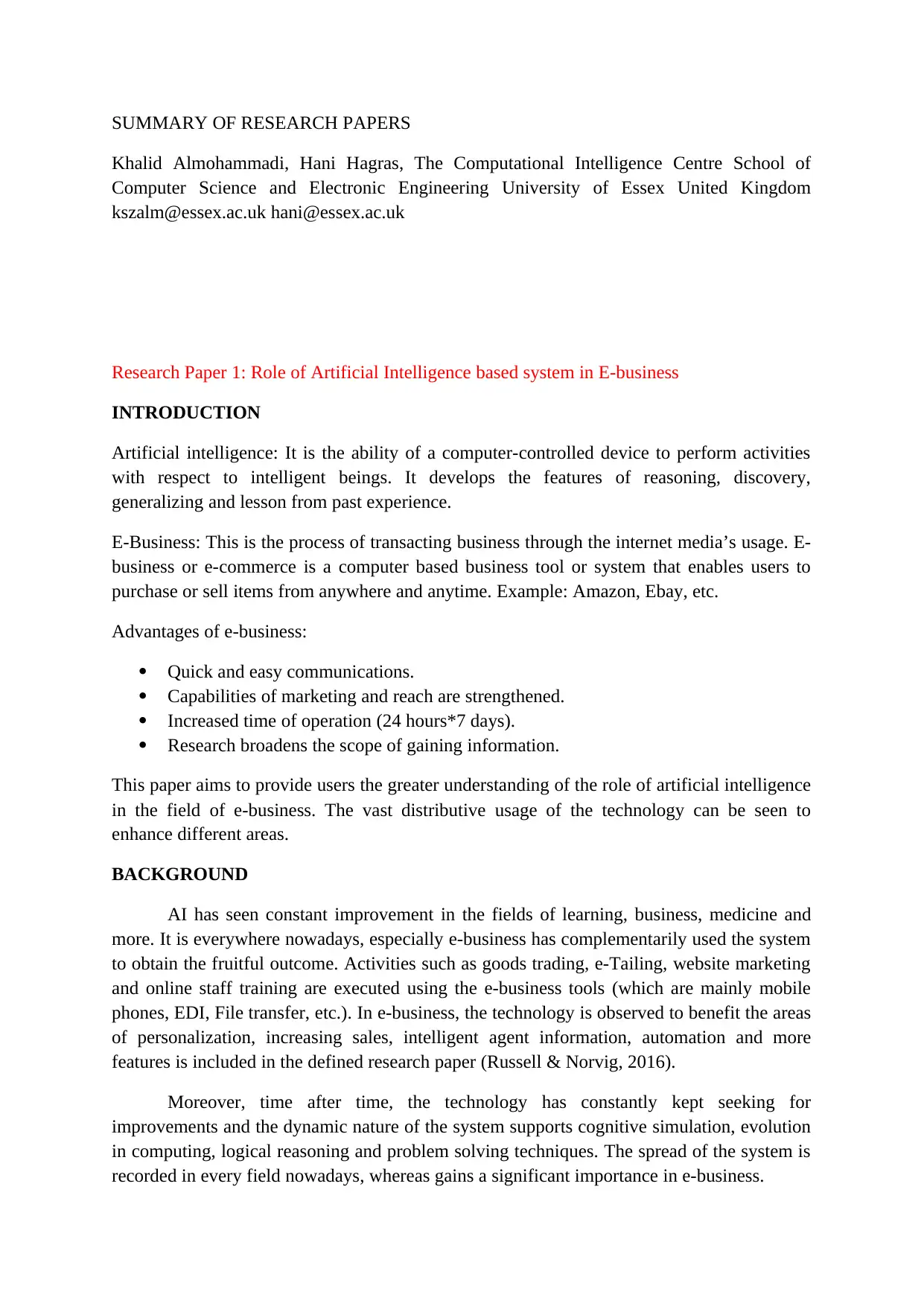
SUMMARY OF RESEARCH PAPERS
Khalid Almohammadi, Hani Hagras, The Computational Intelligence Centre School of
Computer Science and Electronic Engineering University of Essex United Kingdom
kszalm@essex.ac.uk hani@essex.ac.uk
Research Paper 1: Role of Artificial Intelligence based system in E-business
INTRODUCTION
Artificial intelligence: It is the ability of a computer-controlled device to perform activities
with respect to intelligent beings. It develops the features of reasoning, discovery,
generalizing and lesson from past experience.
E-Business: This is the process of transacting business through the internet media’s usage. E-
business or e-commerce is a computer based business tool or system that enables users to
purchase or sell items from anywhere and anytime. Example: Amazon, Ebay, etc.
Advantages of e-business:
Quick and easy communications.
Capabilities of marketing and reach are strengthened.
Increased time of operation (24 hours*7 days).
Research broadens the scope of gaining information.
This paper aims to provide users the greater understanding of the role of artificial intelligence
in the field of e-business. The vast distributive usage of the technology can be seen to
enhance different areas.
BACKGROUND
AI has seen constant improvement in the fields of learning, business, medicine and
more. It is everywhere nowadays, especially e-business has complementarily used the system
to obtain the fruitful outcome. Activities such as goods trading, e-Tailing, website marketing
and online staff training are executed using the e-business tools (which are mainly mobile
phones, EDI, File transfer, etc.). In e-business, the technology is observed to benefit the areas
of personalization, increasing sales, intelligent agent information, automation and more
features is included in the defined research paper (Russell & Norvig, 2016).
Moreover, time after time, the technology has constantly kept seeking for
improvements and the dynamic nature of the system supports cognitive simulation, evolution
in computing, logical reasoning and problem solving techniques. The spread of the system is
recorded in every field nowadays, whereas gains a significant importance in e-business.
Khalid Almohammadi, Hani Hagras, The Computational Intelligence Centre School of
Computer Science and Electronic Engineering University of Essex United Kingdom
kszalm@essex.ac.uk hani@essex.ac.uk
Research Paper 1: Role of Artificial Intelligence based system in E-business
INTRODUCTION
Artificial intelligence: It is the ability of a computer-controlled device to perform activities
with respect to intelligent beings. It develops the features of reasoning, discovery,
generalizing and lesson from past experience.
E-Business: This is the process of transacting business through the internet media’s usage. E-
business or e-commerce is a computer based business tool or system that enables users to
purchase or sell items from anywhere and anytime. Example: Amazon, Ebay, etc.
Advantages of e-business:
Quick and easy communications.
Capabilities of marketing and reach are strengthened.
Increased time of operation (24 hours*7 days).
Research broadens the scope of gaining information.
This paper aims to provide users the greater understanding of the role of artificial intelligence
in the field of e-business. The vast distributive usage of the technology can be seen to
enhance different areas.
BACKGROUND
AI has seen constant improvement in the fields of learning, business, medicine and
more. It is everywhere nowadays, especially e-business has complementarily used the system
to obtain the fruitful outcome. Activities such as goods trading, e-Tailing, website marketing
and online staff training are executed using the e-business tools (which are mainly mobile
phones, EDI, File transfer, etc.). In e-business, the technology is observed to benefit the areas
of personalization, increasing sales, intelligent agent information, automation and more
features is included in the defined research paper (Russell & Norvig, 2016).
Moreover, time after time, the technology has constantly kept seeking for
improvements and the dynamic nature of the system supports cognitive simulation, evolution
in computing, logical reasoning and problem solving techniques. The spread of the system is
recorded in every field nowadays, whereas gains a significant importance in e-business.
Secure Best Marks with AI Grader
Need help grading? Try our AI Grader for instant feedback on your assignments.
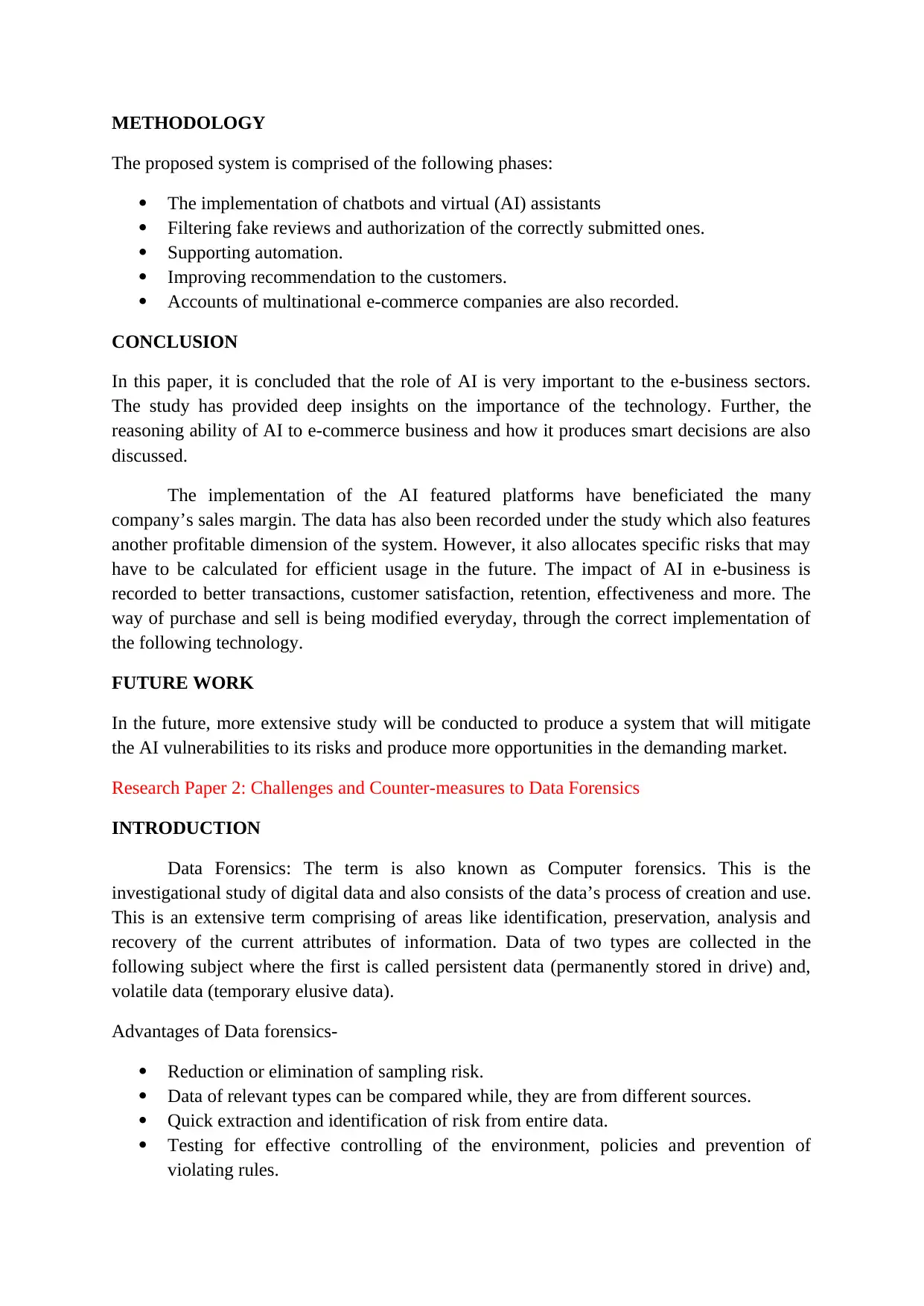
METHODOLOGY
The proposed system is comprised of the following phases:
The implementation of chatbots and virtual (AI) assistants
Filtering fake reviews and authorization of the correctly submitted ones.
Supporting automation.
Improving recommendation to the customers.
Accounts of multinational e-commerce companies are also recorded.
CONCLUSION
In this paper, it is concluded that the role of AI is very important to the e-business sectors.
The study has provided deep insights on the importance of the technology. Further, the
reasoning ability of AI to e-commerce business and how it produces smart decisions are also
discussed.
The implementation of the AI featured platforms have beneficiated the many
company’s sales margin. The data has also been recorded under the study which also features
another profitable dimension of the system. However, it also allocates specific risks that may
have to be calculated for efficient usage in the future. The impact of AI in e-business is
recorded to better transactions, customer satisfaction, retention, effectiveness and more. The
way of purchase and sell is being modified everyday, through the correct implementation of
the following technology.
FUTURE WORK
In the future, more extensive study will be conducted to produce a system that will mitigate
the AI vulnerabilities to its risks and produce more opportunities in the demanding market.
Research Paper 2: Challenges and Counter-measures to Data Forensics
INTRODUCTION
Data Forensics: The term is also known as Computer forensics. This is the
investigational study of digital data and also consists of the data’s process of creation and use.
This is an extensive term comprising of areas like identification, preservation, analysis and
recovery of the current attributes of information. Data of two types are collected in the
following subject where the first is called persistent data (permanently stored in drive) and,
volatile data (temporary elusive data).
Advantages of Data forensics-
Reduction or elimination of sampling risk.
Data of relevant types can be compared while, they are from different sources.
Quick extraction and identification of risk from entire data.
Testing for effective controlling of the environment, policies and prevention of
violating rules.
The proposed system is comprised of the following phases:
The implementation of chatbots and virtual (AI) assistants
Filtering fake reviews and authorization of the correctly submitted ones.
Supporting automation.
Improving recommendation to the customers.
Accounts of multinational e-commerce companies are also recorded.
CONCLUSION
In this paper, it is concluded that the role of AI is very important to the e-business sectors.
The study has provided deep insights on the importance of the technology. Further, the
reasoning ability of AI to e-commerce business and how it produces smart decisions are also
discussed.
The implementation of the AI featured platforms have beneficiated the many
company’s sales margin. The data has also been recorded under the study which also features
another profitable dimension of the system. However, it also allocates specific risks that may
have to be calculated for efficient usage in the future. The impact of AI in e-business is
recorded to better transactions, customer satisfaction, retention, effectiveness and more. The
way of purchase and sell is being modified everyday, through the correct implementation of
the following technology.
FUTURE WORK
In the future, more extensive study will be conducted to produce a system that will mitigate
the AI vulnerabilities to its risks and produce more opportunities in the demanding market.
Research Paper 2: Challenges and Counter-measures to Data Forensics
INTRODUCTION
Data Forensics: The term is also known as Computer forensics. This is the
investigational study of digital data and also consists of the data’s process of creation and use.
This is an extensive term comprising of areas like identification, preservation, analysis and
recovery of the current attributes of information. Data of two types are collected in the
following subject where the first is called persistent data (permanently stored in drive) and,
volatile data (temporary elusive data).
Advantages of Data forensics-
Reduction or elimination of sampling risk.
Data of relevant types can be compared while, they are from different sources.
Quick extraction and identification of risk from entire data.
Testing for effective controlling of the environment, policies and prevention of
violating rules.
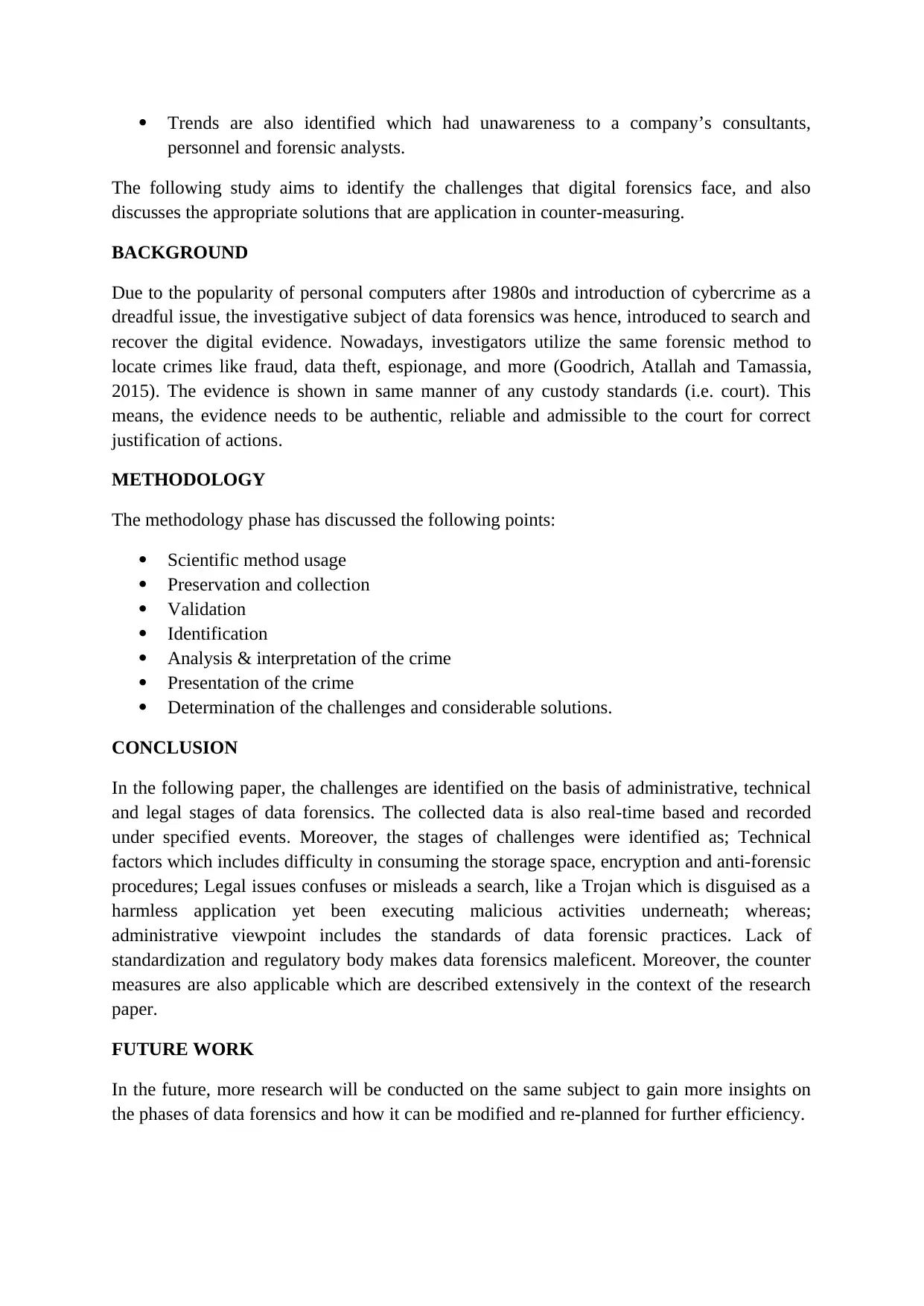
Trends are also identified which had unawareness to a company’s consultants,
personnel and forensic analysts.
The following study aims to identify the challenges that digital forensics face, and also
discusses the appropriate solutions that are application in counter-measuring.
BACKGROUND
Due to the popularity of personal computers after 1980s and introduction of cybercrime as a
dreadful issue, the investigative subject of data forensics was hence, introduced to search and
recover the digital evidence. Nowadays, investigators utilize the same forensic method to
locate crimes like fraud, data theft, espionage, and more (Goodrich, Atallah and Tamassia,
2015). The evidence is shown in same manner of any custody standards (i.e. court). This
means, the evidence needs to be authentic, reliable and admissible to the court for correct
justification of actions.
METHODOLOGY
The methodology phase has discussed the following points:
Scientific method usage
Preservation and collection
Validation
Identification
Analysis & interpretation of the crime
Presentation of the crime
Determination of the challenges and considerable solutions.
CONCLUSION
In the following paper, the challenges are identified on the basis of administrative, technical
and legal stages of data forensics. The collected data is also real-time based and recorded
under specified events. Moreover, the stages of challenges were identified as; Technical
factors which includes difficulty in consuming the storage space, encryption and anti-forensic
procedures; Legal issues confuses or misleads a search, like a Trojan which is disguised as a
harmless application yet been executing malicious activities underneath; whereas;
administrative viewpoint includes the standards of data forensic practices. Lack of
standardization and regulatory body makes data forensics maleficent. Moreover, the counter
measures are also applicable which are described extensively in the context of the research
paper.
FUTURE WORK
In the future, more research will be conducted on the same subject to gain more insights on
the phases of data forensics and how it can be modified and re-planned for further efficiency.
personnel and forensic analysts.
The following study aims to identify the challenges that digital forensics face, and also
discusses the appropriate solutions that are application in counter-measuring.
BACKGROUND
Due to the popularity of personal computers after 1980s and introduction of cybercrime as a
dreadful issue, the investigative subject of data forensics was hence, introduced to search and
recover the digital evidence. Nowadays, investigators utilize the same forensic method to
locate crimes like fraud, data theft, espionage, and more (Goodrich, Atallah and Tamassia,
2015). The evidence is shown in same manner of any custody standards (i.e. court). This
means, the evidence needs to be authentic, reliable and admissible to the court for correct
justification of actions.
METHODOLOGY
The methodology phase has discussed the following points:
Scientific method usage
Preservation and collection
Validation
Identification
Analysis & interpretation of the crime
Presentation of the crime
Determination of the challenges and considerable solutions.
CONCLUSION
In the following paper, the challenges are identified on the basis of administrative, technical
and legal stages of data forensics. The collected data is also real-time based and recorded
under specified events. Moreover, the stages of challenges were identified as; Technical
factors which includes difficulty in consuming the storage space, encryption and anti-forensic
procedures; Legal issues confuses or misleads a search, like a Trojan which is disguised as a
harmless application yet been executing malicious activities underneath; whereas;
administrative viewpoint includes the standards of data forensic practices. Lack of
standardization and regulatory body makes data forensics maleficent. Moreover, the counter
measures are also applicable which are described extensively in the context of the research
paper.
FUTURE WORK
In the future, more research will be conducted on the same subject to gain more insights on
the phases of data forensics and how it can be modified and re-planned for further efficiency.
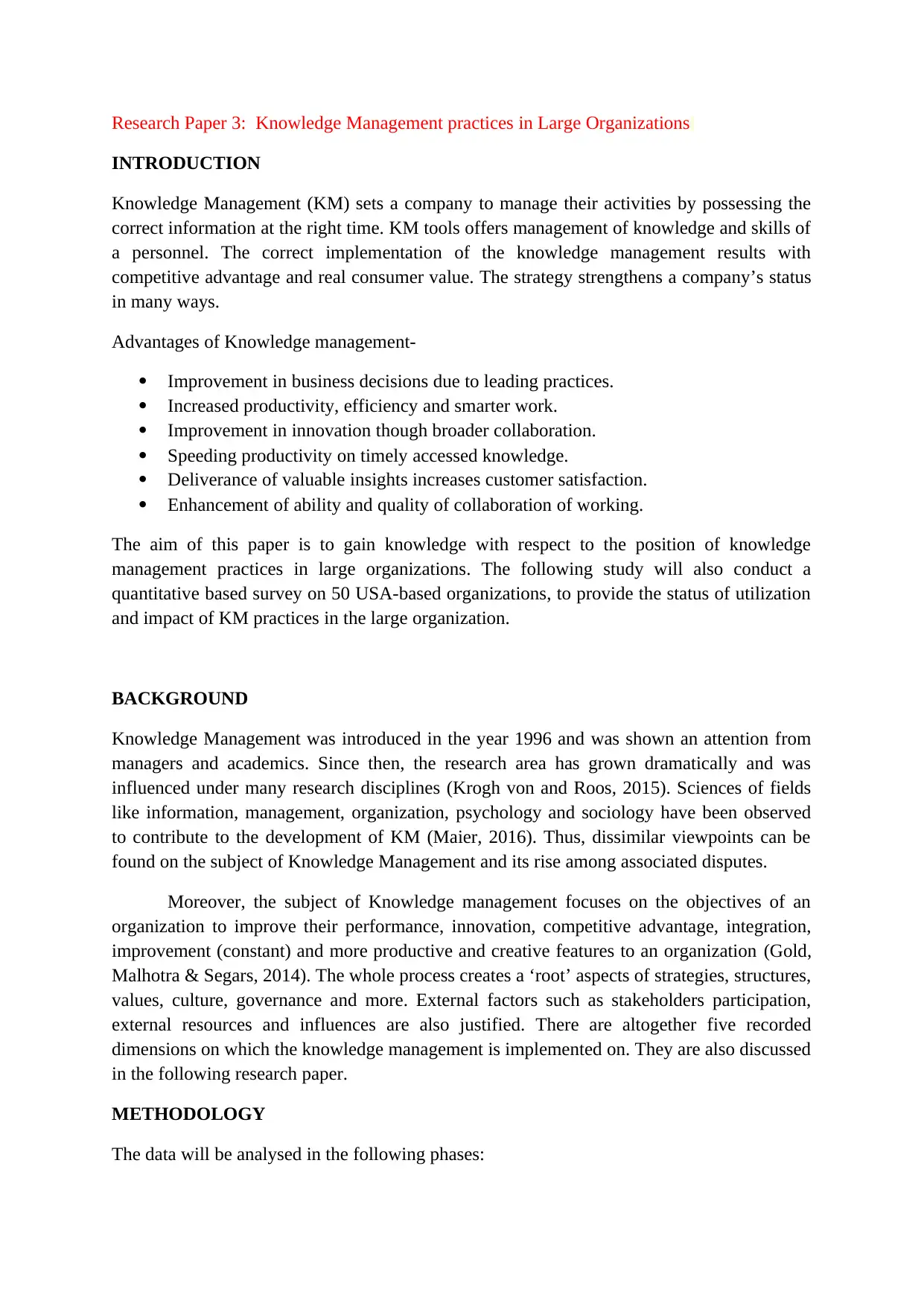
Research Paper 3: Knowledge Management practices in Large Organizations
INTRODUCTION
Knowledge Management (KM) sets a company to manage their activities by possessing the
correct information at the right time. KM tools offers management of knowledge and skills of
a personnel. The correct implementation of the knowledge management results with
competitive advantage and real consumer value. The strategy strengthens a company’s status
in many ways.
Advantages of Knowledge management-
Improvement in business decisions due to leading practices.
Increased productivity, efficiency and smarter work.
Improvement in innovation though broader collaboration.
Speeding productivity on timely accessed knowledge.
Deliverance of valuable insights increases customer satisfaction.
Enhancement of ability and quality of collaboration of working.
The aim of this paper is to gain knowledge with respect to the position of knowledge
management practices in large organizations. The following study will also conduct a
quantitative based survey on 50 USA-based organizations, to provide the status of utilization
and impact of KM practices in the large organization.
BACKGROUND
Knowledge Management was introduced in the year 1996 and was shown an attention from
managers and academics. Since then, the research area has grown dramatically and was
influenced under many research disciplines (Krogh von and Roos, 2015). Sciences of fields
like information, management, organization, psychology and sociology have been observed
to contribute to the development of KM (Maier, 2016). Thus, dissimilar viewpoints can be
found on the subject of Knowledge Management and its rise among associated disputes.
Moreover, the subject of Knowledge management focuses on the objectives of an
organization to improve their performance, innovation, competitive advantage, integration,
improvement (constant) and more productive and creative features to an organization (Gold,
Malhotra & Segars, 2014). The whole process creates a ‘root’ aspects of strategies, structures,
values, culture, governance and more. External factors such as stakeholders participation,
external resources and influences are also justified. There are altogether five recorded
dimensions on which the knowledge management is implemented on. They are also discussed
in the following research paper.
METHODOLOGY
The data will be analysed in the following phases:
INTRODUCTION
Knowledge Management (KM) sets a company to manage their activities by possessing the
correct information at the right time. KM tools offers management of knowledge and skills of
a personnel. The correct implementation of the knowledge management results with
competitive advantage and real consumer value. The strategy strengthens a company’s status
in many ways.
Advantages of Knowledge management-
Improvement in business decisions due to leading practices.
Increased productivity, efficiency and smarter work.
Improvement in innovation though broader collaboration.
Speeding productivity on timely accessed knowledge.
Deliverance of valuable insights increases customer satisfaction.
Enhancement of ability and quality of collaboration of working.
The aim of this paper is to gain knowledge with respect to the position of knowledge
management practices in large organizations. The following study will also conduct a
quantitative based survey on 50 USA-based organizations, to provide the status of utilization
and impact of KM practices in the large organization.
BACKGROUND
Knowledge Management was introduced in the year 1996 and was shown an attention from
managers and academics. Since then, the research area has grown dramatically and was
influenced under many research disciplines (Krogh von and Roos, 2015). Sciences of fields
like information, management, organization, psychology and sociology have been observed
to contribute to the development of KM (Maier, 2016). Thus, dissimilar viewpoints can be
found on the subject of Knowledge Management and its rise among associated disputes.
Moreover, the subject of Knowledge management focuses on the objectives of an
organization to improve their performance, innovation, competitive advantage, integration,
improvement (constant) and more productive and creative features to an organization (Gold,
Malhotra & Segars, 2014). The whole process creates a ‘root’ aspects of strategies, structures,
values, culture, governance and more. External factors such as stakeholders participation,
external resources and influences are also justified. There are altogether five recorded
dimensions on which the knowledge management is implemented on. They are also discussed
in the following research paper.
METHODOLOGY
The data will be analysed in the following phases:
Secure Best Marks with AI Grader
Need help grading? Try our AI Grader for instant feedback on your assignments.
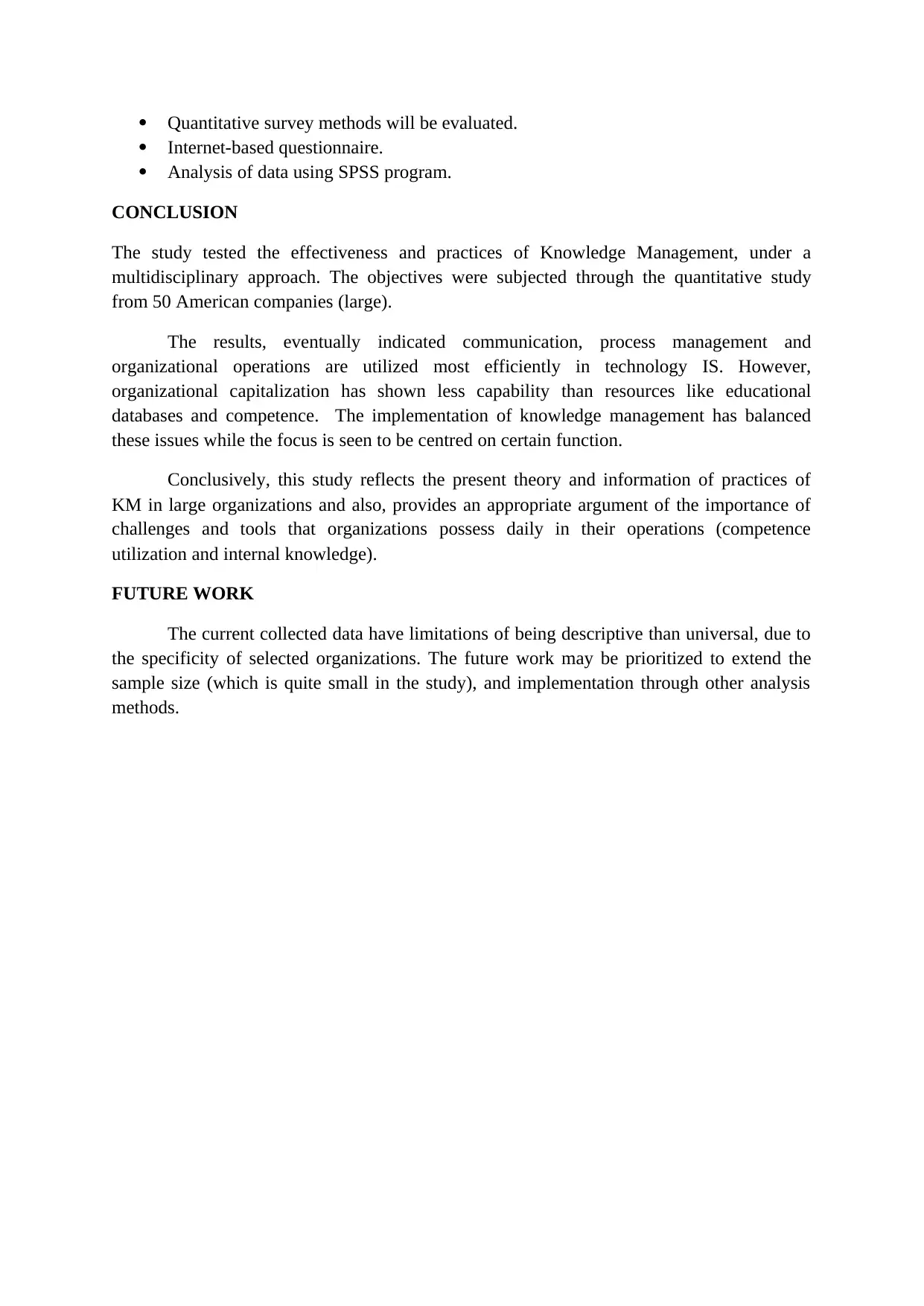
Quantitative survey methods will be evaluated.
Internet-based questionnaire.
Analysis of data using SPSS program.
CONCLUSION
The study tested the effectiveness and practices of Knowledge Management, under a
multidisciplinary approach. The objectives were subjected through the quantitative study
from 50 American companies (large).
The results, eventually indicated communication, process management and
organizational operations are utilized most efficiently in technology IS. However,
organizational capitalization has shown less capability than resources like educational
databases and competence. The implementation of knowledge management has balanced
these issues while the focus is seen to be centred on certain function.
Conclusively, this study reflects the present theory and information of practices of
KM in large organizations and also, provides an appropriate argument of the importance of
challenges and tools that organizations possess daily in their operations (competence
utilization and internal knowledge).
FUTURE WORK
The current collected data have limitations of being descriptive than universal, due to
the specificity of selected organizations. The future work may be prioritized to extend the
sample size (which is quite small in the study), and implementation through other analysis
methods.
Internet-based questionnaire.
Analysis of data using SPSS program.
CONCLUSION
The study tested the effectiveness and practices of Knowledge Management, under a
multidisciplinary approach. The objectives were subjected through the quantitative study
from 50 American companies (large).
The results, eventually indicated communication, process management and
organizational operations are utilized most efficiently in technology IS. However,
organizational capitalization has shown less capability than resources like educational
databases and competence. The implementation of knowledge management has balanced
these issues while the focus is seen to be centred on certain function.
Conclusively, this study reflects the present theory and information of practices of
KM in large organizations and also, provides an appropriate argument of the importance of
challenges and tools that organizations possess daily in their operations (competence
utilization and internal knowledge).
FUTURE WORK
The current collected data have limitations of being descriptive than universal, due to
the specificity of selected organizations. The future work may be prioritized to extend the
sample size (which is quite small in the study), and implementation through other analysis
methods.
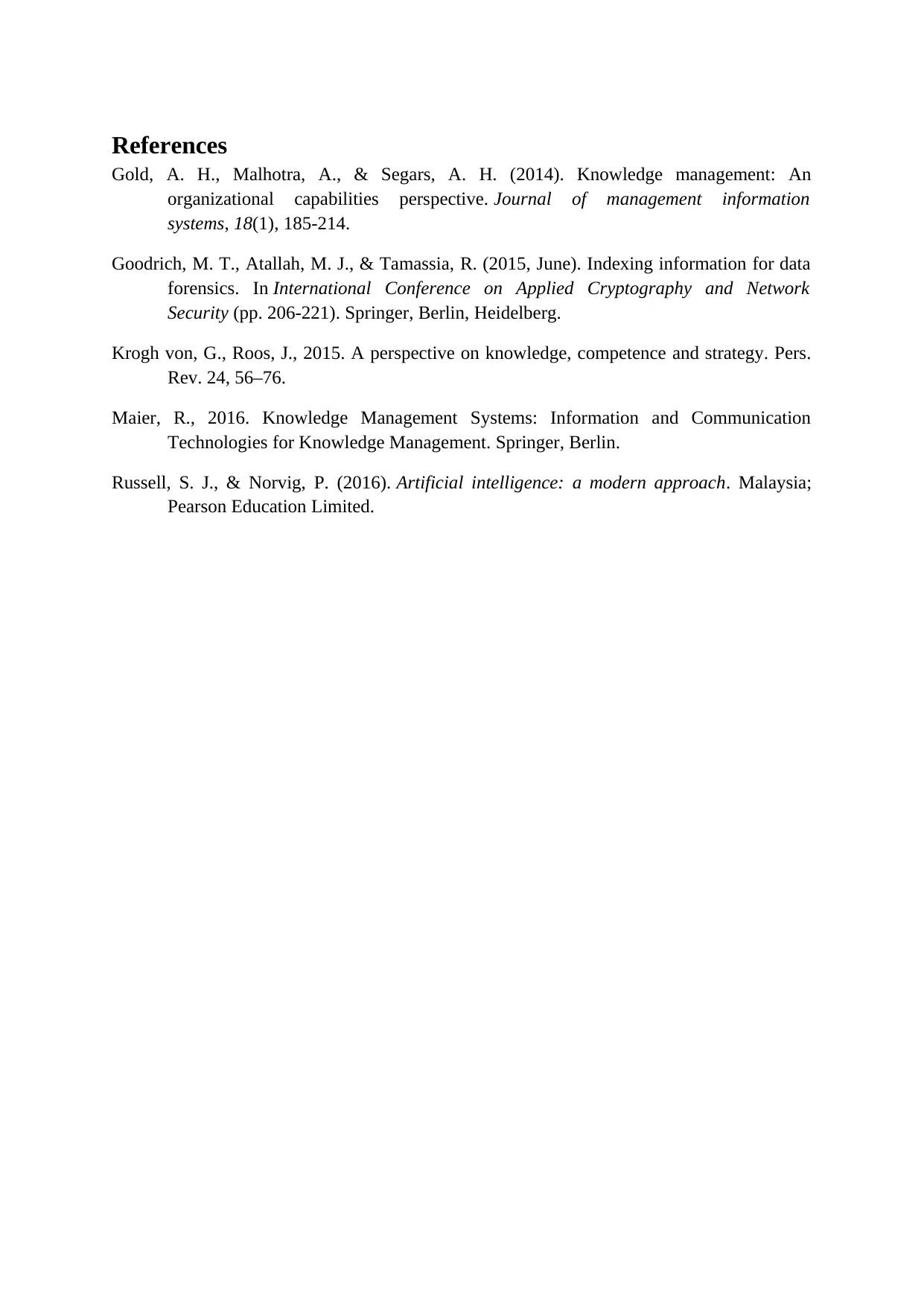
References
Gold, A. H., Malhotra, A., & Segars, A. H. (2014). Knowledge management: An
organizational capabilities perspective. Journal of management information
systems, 18(1), 185-214.
Goodrich, M. T., Atallah, M. J., & Tamassia, R. (2015, June). Indexing information for data
forensics. In International Conference on Applied Cryptography and Network
Security (pp. 206-221). Springer, Berlin, Heidelberg.
Krogh von, G., Roos, J., 2015. A perspective on knowledge, competence and strategy. Pers.
Rev. 24, 56–76.
Maier, R., 2016. Knowledge Management Systems: Information and Communication
Technologies for Knowledge Management. Springer, Berlin.
Russell, S. J., & Norvig, P. (2016). Artificial intelligence: a modern approach. Malaysia;
Pearson Education Limited.
Gold, A. H., Malhotra, A., & Segars, A. H. (2014). Knowledge management: An
organizational capabilities perspective. Journal of management information
systems, 18(1), 185-214.
Goodrich, M. T., Atallah, M. J., & Tamassia, R. (2015, June). Indexing information for data
forensics. In International Conference on Applied Cryptography and Network
Security (pp. 206-221). Springer, Berlin, Heidelberg.
Krogh von, G., Roos, J., 2015. A perspective on knowledge, competence and strategy. Pers.
Rev. 24, 56–76.
Maier, R., 2016. Knowledge Management Systems: Information and Communication
Technologies for Knowledge Management. Springer, Berlin.
Russell, S. J., & Norvig, P. (2016). Artificial intelligence: a modern approach. Malaysia;
Pearson Education Limited.
1 out of 6
Related Documents
Your All-in-One AI-Powered Toolkit for Academic Success.
+13062052269
info@desklib.com
Available 24*7 on WhatsApp / Email
![[object Object]](/_next/static/media/star-bottom.7253800d.svg)
Unlock your academic potential
© 2024 | Zucol Services PVT LTD | All rights reserved.





